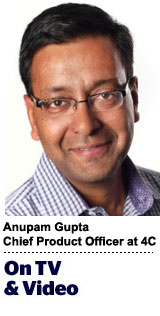 “On TV And Video” is a column exploring opportunities and challenges in advanced TV and video.
“On TV And Video” is a column exploring opportunities and challenges in advanced TV and video.
Today’s column is written by Anupam Gupta, chief product officer at 4C.
Snap was recently in the headlines with disappointing financials for its second quarter in a row, but the company is already one step ahead thinking of ways to overhaul the app to make it easier for consumers to engage with and use. Rethinking the way Snapchat works could open up a huge audience of new users – or, even better, a new purpose for the platform.
Today’s marketers (and investors) are looking at Snapchat as a social media platform versus taking into consideration Snap’s advancements in other areas of technology, such as augmented reality and original content. These characteristics resonate best with TV, so why aren’t we comparing it more to the big screen? Recent deals with top TV networks, such as Turner, NBCU and Discovery Communications, suggest there is a strength beyond what meets the social-media eye.
I’m not the only one seeing this angle. Industry experts from Forrester suggest that Snapchat could compete with the likes of Viacom’s networks, including VH1, Nickelodeon and Comedy Central, which generated $4.8 billion in ad revenue last year. And recently, the Television Academy signed a three-year contract to expand coverage by creating Snap Stories that capture personal and behind-the-scenes moments at the Emmys.
To put Snap in the proper context, think back to the era of “Must-See TV” where families sat down at the same time each night to tune in to the most-watched, most-popular TV show of the time. It was much easier then for brands and advertisers to operate. Brands could showcase their new product or service to people who were fully engaged in one program for a specific amount of time, and they could do so without multiscreen distractions. It was the era of putting great creative in front of a large audience, in an attempt to convince some of them to add the product or service to tomorrow’s shopping list.
We’ve gone a little off course since then, thanks to the evolution of multi-screening, streaming and recording and on-demand services. These advancements have been great for consumers, but have in turn made the jobs of many TV buyers a lot harder, nearly stripping them of the control they once had. Until now.
With Snapchat, everyday users, publishers or celebrities can post their own content in real time to millions of global viewers who are constantly scrolling through their feeds searching for their next unwatched story. It’s addicting. And it’s keeping users’ attention on the small screen at a time when 47% of millenials and Gen Xers are unreachable by traditional TV measurements.
So what does this mean for advertisers? Don’t treat Snap like a social network. The same creative that works on Facebook and Twitter will not work here. The ad format is different. The audience is different, and the context is different. Think about what engages people on the big screen. It’s about storytelling. Brands must bring their best sight, sound and motion, and pack it in under 10 seconds.
Furthermore, measurement of Snap Ads should be more akin to television. Think about reach and frequency against the target audience. Track engagement rates and benchmark against video ads on other channels.
At the end of the day, Snap isn’t looking to change the TV model; it’s looking to emulate it for a new generation. Much of what appears on Snapchat may resemble TV’s glory days, with interrupting commercials and content that always fills the screen. With that in mind, TV buyers should embrace Snap as an ad vehicle because of its familiar components: must-see content with audience-driven engagement that allows TV buyers to take back some of the control they once had.
Follow 4C (@4Cinsights) and AdExchanger (@adexchanger) on Twitter.
This post was syndicated from Ad Exchanger.

More Stories
LUMO expands sales team with three new hires
Friday, March 7 Evening Cable News Ratings: Rachel Maddow Sweeps the Week for MSNBC
Tegna Names John Treviño GM of WKYC in Cleveland